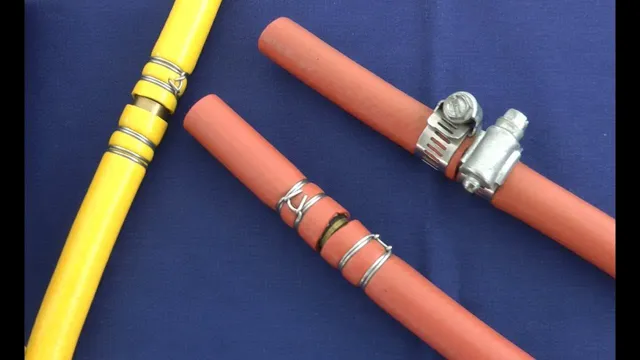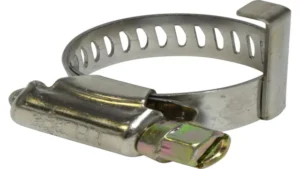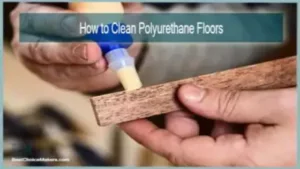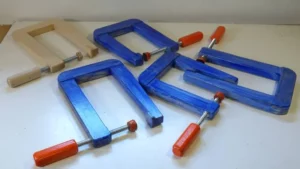Have you ever worked with hose clamps and found yourself wondering if you were using them safely? It’s important to use hose clamps correctly to ensure the safety of yourself and those around you. Hose clamps are commonly used in many industries, including automotive, plumbing, and industrial manufacturing, to secure hoses and pipes in place. However, improper use and installation of hose clamps can lead to the hose slipping off and causing leaks, which can be dangerous in certain situations.
In this blog post, we’ll give you some tips on how to use hose clamps safely and avoid any potential hazards.
What are Hose Clamps?
Hose clamps are devices used to securely fasten hoses onto fittings, preventing leaks and ensuring a tight seal. They come in various types, including worm gear, spring, and ear clamps, each with its unique features and applications. So, how do you use hose clamps? Firstly, ensure you have the correct size for your hose and fitting, and then position the clamp over the hose, compressing it onto the fitting with a screwdriver or pliers.
After tightening, check for any leaks or gaps, and adjust accordingly. It’s essential to use hose clamps that are suitable for the application, whether it’s industrial, automotive, or household, as the wrong type of clamp or incorrect installation can lead to safety hazards and inefficiencies. With the right hose clamp, you can safely and confidently connect hoses for your desired application.
Introduction to Hose Clamps
Hose clamps are a crucial component of any plumbing or automotive system. These small but powerful devices are used to secure hoses or pipes to fittings, preventing leaks or other failures that could cause serious damage. Hose clamps typically consist of a band made of metal or plastic, with a worm gear or other mechanism used to tighten the band around the hose or pipe.
They come in a variety of sizes and materials to accommodate different applications, from simple garden hoses to complex industrial systems. Whether you’re a professional mechanic or a DIY enthusiast, understanding how hose clamps work and how to choose the right type and size for your needs is essential for keeping your systems running smoothly and avoiding costly repairs.
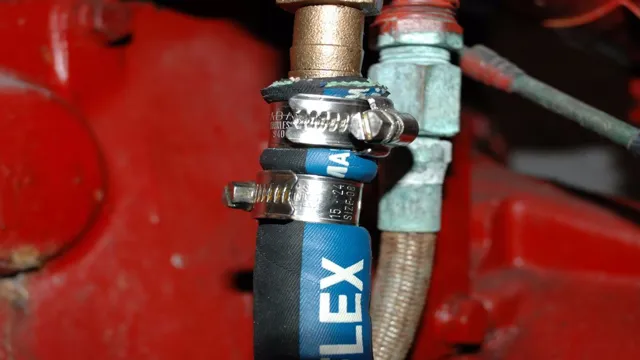
Types of Hose Clamps
Hose clamps are an essential component when it comes to ensuring a tight seal between hoses and fittings. These clamps, also known as hose clips, are devices used to attach and seal hoses onto barbs or spigots. The clamps are made up of a material like metal or plastic and have a screw or band mechanism that tightens around the hose to create a compression seal.
There are various types of hose clamps available in the market, and the type of clamp used depends on the application requirements. Some common types of hose clamps include screw clamps, spring clamps, wire clamps, and t-bolt clamps. Screw clamps are easy to install and can be used for a wide range of applications.
Spring clamps are typically used in automotive applications and are easy to install without the need for special tools. Wire clamps offer excellent sealing and are ideal for high-pressure applications. T-bolt clamps are used in heavy-duty applications that require high strength and are commonly found in industrial and commercial settings.
Overall, understanding the different types of hose clamps available will help ensure that the right type of clamp is selected for the application and will ensure a safe and leak-free connection.
Using Hose Clamps: Step-by-step Guide
If you need to secure hoses, pipes, or tubes, using hose clamps can be a quick and easy solution. But how do you use hose clamps correctly? Firstly, make sure that you have the proper size of clamp for your hose. Begin by sliding the clamp onto the hose, making sure the clamp is positioned evenly over the joint.
Then, use a screwdriver to tighten the clamp, keeping it firmly in place. Don’t over-tighten the clamp, as this can cause damage to the hose or potentially break the clamp. It’s also worth remembering that hose clamps can loosen over time, so it’s important to check them periodically to ensure that they are still secure.
By knowing how to properly use hose clamps, you can ensure that your hoses and pipes stay securely attached, giving you peace of mind. So the next time you need to connect a hose, remember these simple steps and get clamping!
Step 1: Choose the Correct Hose Clamp
Hose Clamp Using hose clamps might seem like a simple task, but choosing the correct one is crucial. With many types of clamps available, selecting the wrong one can lead to leaks and even damage to your equipment. To start, identify the type of hose you are using and choose the appropriate clamp material accordingly.
Stainless steel clamps are recommended for water-based applications, while plastic or brass clamps are suitable for fuel and oil-based systems. Additionally, consider the diameter of the hose you are clamping to select the right size clamp. Choosing the correct hose clamp upfront will ensure secure and leak-free connections for optimal performance.
Step 2: Loosen and Prepare the Clamp
When using hose clamps, it’s important to loosen and prepare them properly in order to get the job done right. First, make sure to locate the clamp on the hose that you need to adjust or remove. You can do this by looking for the metal band that wraps around the hose and tightening the screw or bolt that holds it in place.
Once you’ve found the clamp, use a screwdriver or pliers to loosen the tension on it. This will allow you to adjust or remove the hose more easily and prevent any damage to the hose or clamp. Make sure to keep a firm grip on the clamp while loosening it to avoid slipping or damaging the hose.
With the clamp loosened, you can move on to the next step of preparing it for use. By following these steps, you can ensure that your hose clamp will work effectively without causing any damage to your equipment.
Step 3: Position the Hose
When it comes to positioning the hose, hose clamps are essential for a secure and leak-free connection. To start, make sure that both ends of the hose are clean and free of debris. Then, slide one end of the hose onto the fitting and tighten the hose clamp using a screwdriver.
The clamp should be snug, but not overtightened, as this can cause damage to the hose. Repeat this process with the other end of the hose, ensuring that both clamps are equidistant from the center of the fitting. Once the clamps are in place, double-check the connection for any signs of leaks.
With these simple steps and proper use of hose clamps, you will have a secure and reliable hose connection that can withstand even the toughest conditions.
Step 4: Tighten the Clamp
When it comes to securing hoses, hose clamps are an essential tool to ensure a tight seal. Tightening the clamp is the final step in the process of securing a hose. It’s important to use the appropriate size clamp for your hose, as a loose clamp will result in leaks while an overly tight clamp can cause damage to the hose.
Start by placing the clamp onto the hose, making sure it’s in the desired position. Then tighten the screw on the clamp using a screwdriver or pliers, making sure it’s tight enough to hold the hose in place but not too tight that it damages the hose. A good rule of thumb is to tighten the clamp until you feel resistance, then give it one more quarter turn.
With a properly tightened hose clamp, you can be confident that your hoses will stay securely in place and your equipment will run smoothly.
Step 5: Check the Fit
Now that the hose has been attached to the fitting, it’s time to check the fit to ensure everything is secure and tight. This is an important step to prevent leaks or disconnects. One way to do this is by using hose clamps, which can be easily tightened with a screwdriver.
Simply place the hose clamp around the base of the fitting and tighten until it feels secure. However, it’s important not to overtighten the clamp as this can cause damage to the hose or fitting. A good rule of thumb is to tighten the clamp until it feels snug, but not so tight that it’s difficult to turn.
Once the clamp is in place, give the hose a gentle tug to make sure it’s firmly attached. If it feels loose or comes off easily, adjust the clamp and try again. With a little patience and care, you’ll have a perfectly fitted hose that’s ready to use in no time.
Tips and Tricks for Using Hose Clamps
If you’re working on a project that involves attaching hoses to different types of equipment, knowing how to use hose clamps is essential. Hose clamps are designed to hold hoses securely in place, preventing any leaks or spills. First, you need to identify the size of the hose and select the appropriate size clamp.
Place the clamp over the hose, and ensure that its position is correct before tightening it. When tightening, use a screwdriver or pliers, but be careful not to overtighten, as this could damage the clamp or the hose. Tighten the clamp until it’s snug, but not too tight.
You may also want to consider using a clamp with a built-in tension gauge, which will help you determine the correct amount of pressure to apply. By following these simple steps, you can use hose clamps effectively and prevent any potential mishaps.
Keeping Safe While Using Hose Clamps
Hose clamps are a vital part of any system that uses hoses to transport fluids. They have a crucial role to play in ensuring that the hoses do not come loose, leading to a potential leak or failure. When using hose clamps, it is essential to remember a few tips and tricks to keep yourself safe.
Always wear protective gloves when handling them, as they can cause injury if mishandled. Use the right type of clamp for the job, as some are designed for specific applications and may not be suitable for others. Be sure to tighten the clamp securely, but not too tight, as this can cause damage to the hose or the clamp itself.
Finally, always inspect clamps regularly for signs of wear or damage, and replace them when necessary to maintain safe operation. By following these simple tips, you can ensure that your hose clamps are doing their job effectively and keeping you safe.
Common Mistakes to Avoid
When it comes to using hose clamps, there are a few common mistakes that you will want to avoid in order to ensure that your system stays in good condition. One of the biggest mistakes is not tightening your hose clamps enough. This can lead to leaks and other problems down the line.
Additionally, it is important to make sure that you are using the right size and type of clamp for your system. If the clamp is too large or small, it may not be able to hold the hose securely in place, causing it to slip or otherwise fail. Finally, be sure to inspect your clamps regularly for signs of wear and tear.
If you notice any damage, it is important to replace the clamp as soon as possible to prevent problems from developing. By following these tips and tricks, you can ensure that your hose clamps are working effectively and efficiently to keep your system running smoothly.
Conclusion
And there you have it, folks! The art of hose clamp usage may seem daunting at first, but by following these simple steps, you’ll be a clamping pro in no time. Just remember, when life gives you loose hoses that won’t stay put, be the hero they need and clamp ’em down! Trust us, your pipes and appliances will thank you. Happy clamping!”
FAQs
What are the different types of hose clamps available in the market?
There are mainly four types of hose clamps – screw clamps, spring clamps, wire clamps, and ear clamps.
How do I choose the right size of hose clamp for my application?
To choose the right size of hose clamp, measure the outside diameter of the hose and match it with the clamp’s range of sizes.
Can hose clamps be reused?
Yes, hose clamps can be reused, but it’s better to replace them with new ones if they are damaged or worn out.
How do I install a hose clamp correctly?
To install a hose clamp correctly, first, place it over the hose and tighten the screw or crimp it with pliers until it’s secure.
What is the maximum pressure that a hose clamp can handle?
The maximum pressure that a hose clamp can handle depends on the type and size of the clamp. Check the manufacturer’s specifications for details.
Are there any safety precautions I need to follow while using hose clamps?
Yes, always wear protective gloves and eyewear while handling hose clamps to avoid injury. Also, do not over-tighten the clamp, as it can damage the hose.
Can hose clamps be used in extreme temperatures?
Yes, hose clamps are designed to withstand a wide range of temperatures, but it’s always better to check the manufacturer’s specifications before using them.
